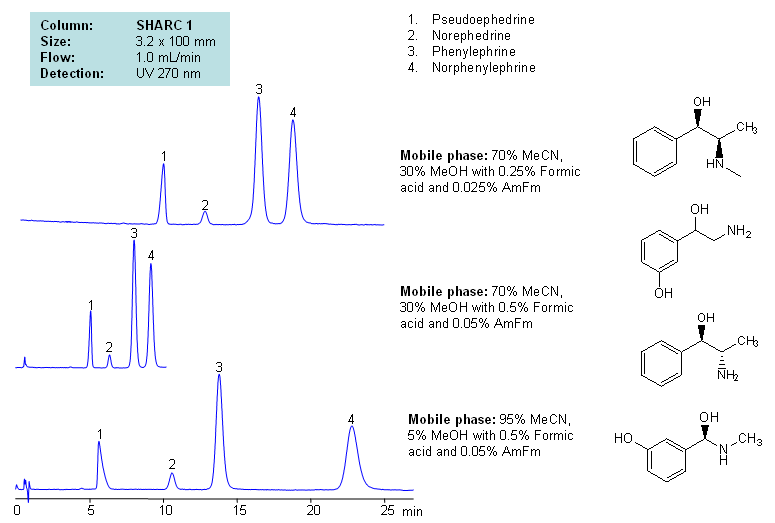
Application Notes: Neurotransmitters are polar basic compounds. Several HPLC techniques are used to analyze these hydrophilic molecules. The most common techniques are reversed-phase with ion-pairing reagents chromatography, ion chromatography, HILIC, and mixed-mode chromatography. SIELC developed a new approach of analysis, which is based on hydrogen bond interactions. Hydrogen-bonding offers unique and alternative selectivity to traditional approaches like reversed-phase, HILIC, ion-exchange, and mixed-mode chromatography. Our methods are fully compatible with ELSD, LC/MS and prep chromatography.
Application Columns: SHARC 1, 3.2×100 mm, 5 um, 100A. To learn more about SHARC 1 columns click here. To order this column click here. To see more chromatographic separations check our web site.
Application compounds: Pseudoephedrine, norephedrine, phenylephrine and norphenylephrine
Detection technique: UV, LC/MS
| Column | Sharc 1, 3.2×100 mm, 5 µm, 100A |
| Mobile Phase | MeCN/MeOH |
| Buffer | AmFm, Formic acid |
| Flow Rate | 1.0 ml/min |
| Detection | UV, 270 nm |
| Class of Compounds |
Drug, Acid, Hydrophilic, Ionizable, Vitamin, Supplements |
| Analyzing Compounds | Pseudoephedrine, Norephedrine, Phenylephrine, Norphenylephrine |
Application Column
SHARC 1
The SHARC™ family of innovative columns represents the first commercially available columns primarily utilizing separation based on hydrogen bonding. SHARC stands for Specific Hydrogen-bond Adsorption Resolution Column. Hydrogen bonding involves an interaction or attraction between a bound hydrogen atom and molecules containing electronegative atoms, such as oxygen, nitrogen, and fluorine.
Select optionsNorphenylephrine
Phenylephrine
Pseudoephedrine (PSE)





